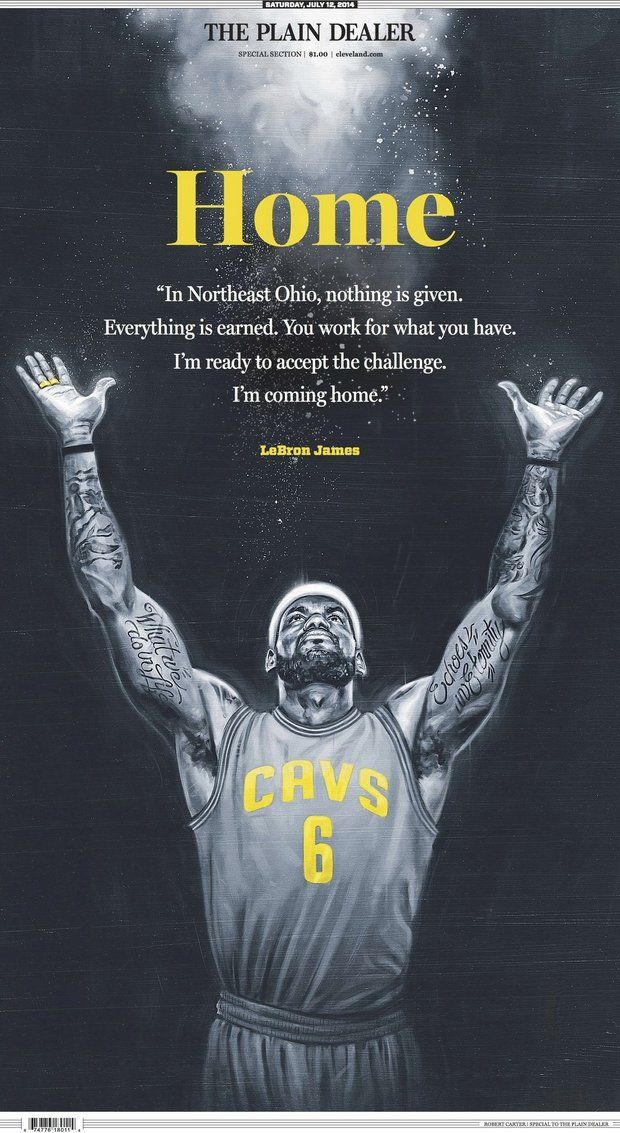Homeward bound and over the top
The Plain Dealer’s front page for Saturday, July 12, 2014. (The Plain Dealer)
Media coverage of Lebron James’ decision to return to Cleveland was over the top, but that’s what sports media do.
Sports reporters have a difficult job. They are often dismissed by “real” reporters as the people over in the toy room, not really doing real journalism, just reporting about games people play. They work in a world where many of the fans, especially in today’s world where press conferences are often available to fans via online stream, often have the same expertise as the reporters. Thus, sports journaists must always work hard to stay one step ahead of their audience.
Sports reporters this summer have found themselves in some interesting places: courtrooms where they covered issues about the NCAA and pay-for-play and police blotters where they chased down news about Florida State quarterback Jameis Winston. And they often find themselves on the front lines of social issues and change in their coverage of Michael Sam (the NFL’s first openly gay player) and Donald Sterling (the NBA owner who made racist comments about players).
That’s not what people think about sports though. Many people follow sports for the hype, the excitement of big news and the go team rah-rah that allows fans to keep in touch with their favorite teams.
So, when sports media went wild over the announcement by James, coming in the form of a self-authored story in Sports Illustrated magazine, sports media performed the way they always do – with over-the-top coverage.
The coverage was so intense on ESPN that it could have been compared to CNN’s non-stop coverage of damaged cruise liners, even prompting one person to tweet something along the lines of “With Lebron going back to Cleveland, why not just dedicate an entire ESPN channel to 24-hour coverage of him?”
It’s what sports media do. It’s a tradition that goes all the way back to the beginning of sports coverage. Sports media builds and loves heroes (until they tear them down). Grantland Rice, in the 1920s, was one of the inventors of this tradition:
“Outlined against a blue-gray October sky, the Four Horsemen rode again. In dramatic lore they are known as Famine, Pestilence, Destruction and Death. These are only aliases. Their real names are Strk uhldreher, Miller, Crowley and Layden. They formed the crest of the South Bend cyclone before which another fighting Army football team was swept over the precipice at the Polo Grounds yesterday afternoon as 55,000 spectators peered down on the bewildering panorama spread on the green plain below.
A cyclone can’t be snared. It may be surrounded, but somewhere it breaks through to keep on going. When the cyclone starts from South Bend, where the candle lights still gleam through the Indiana sycamores, those in the way must take to storm cellars at top speed.
Yesterday the cyclone struck again as Notre Dame beat the Army, 13 to 7, with a set of backfield stars that ripped and crashed through a strong Army defense with more speed and power than the warring cadets could meet.”
New York Herald Tribune, 18 October 1924
That’s hype.
Or take a look at coverage of the Super Bowl, which dedicates an entire week to allowing media to promote everything about the game, the matchup and even preview the commercials.
It’s what sports media do.
So when Sports Illustrated allowed James to write his own story (the Chicago Tribune used to let Chicago Cubs slugger Dave Kingman write his own column in order for them to get better coverage of him) about his choice to go home, then wrote a puff piece about his decision, people didn’t criticize the organization, they praised it. The Cleveland Plain Dealer ran a full page cover the day after his decision, announcing his return.
It was no different than what the Chicago Sun Times did when Michael Jordan returned to the Bulls after quitting baseball (Jordan). It’s what sports media do. And before we start condemning sports media for overhyping Lebron’s decision, let’s take a look at what our political media do. It’s 2014, more than two years before the next presidential election. How often is Hillary being hyped – each day?
